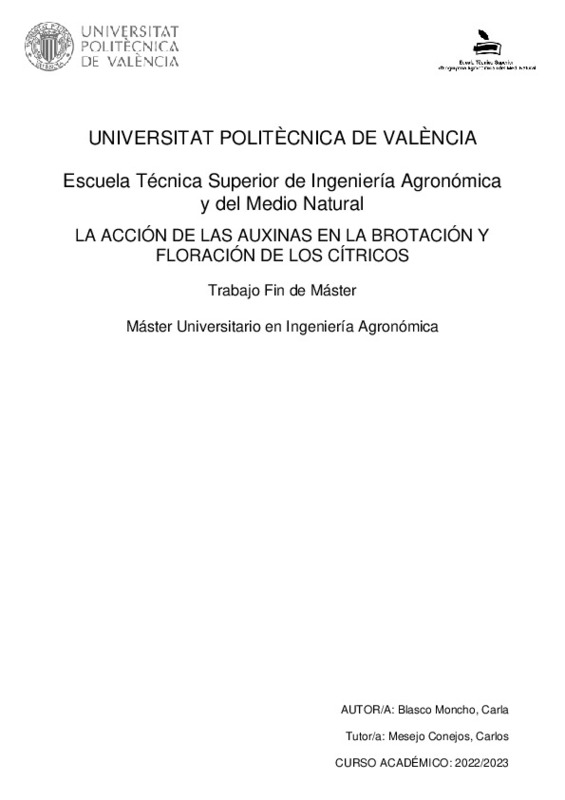|
Resumen:
|
[ES] La producción de los cítricos depende de la intensidad de brotación y floración. En los cítricos, la madera más joven brota y florece con mayor intensidad, pero se desconoce el mecanismo que lo regula.
Los estudios ...[+]
[ES] La producción de los cítricos depende de la intensidad de brotación y floración. En los cítricos, la madera más joven brota y florece con mayor intensidad, pero se desconoce el mecanismo que lo regula.
Los estudios sobre los factores fisiológicos que afectan a la brotación y floración, se basan en dos hipótesis, una hormonal y una nutricional. En la hipótesis hormonal se plantea que la brotación de las yemas axilares se ve afectada por la dominancia apical y, por tanto, la posición del nudo en el brote. La yema apical produce y transporta auxinas que modifica el balance auxinas/citoquininas en las yemas axilares (Axs/CKs). La eliminación del ápice reduce el contenido en auxina y provoca la brotación de yemas axilares. Los nuevos ápices reinician la dominancia apical y establecen un nuevo balance. Pero antes, los carbohidratos se acumulan en la yema provocando la brotación de las yemas axilares. Pero, además, en los cítricos la intensidad de floración también es mayor en las yemas más jóvenes y apicales, las que más brotan. Siendo que todas las yemas reciben la señal inductora, las diferencias en la floración deben ser por cuestiones endógenas.
La hipótesis de este Trabajo Fin de Máster propone que la edad de la madera modifica la capacidad para brotar y florecer por la variación del balance de auxinas.
Para su estudio se determinará la intensidad de floración por cada nudo del brote, distinguiendo entre las maderas de otoño, verano y primavera, se correlacionará la expresión de genes relacionados con la diferenciación floral (LFY), división celular (CYCB2), las giberelinas (GA1 y GA12), citoquininas y auxinas, y el transportador de auxinas (PIN1).
[-]
[EN] Citrus production depends on the intensity of bud sprouting and flowering. In these species, the tree sprouts and blooms with greater intensity on the younger branches, but the mechanism that regulates it is unknown.
The ...[+]
[EN] Citrus production depends on the intensity of bud sprouting and flowering. In these species, the tree sprouts and blooms with greater intensity on the younger branches, but the mechanism that regulates it is unknown.
The hypothesis of this Master's Thesis proposes that the age of the branch modifies the ability to sprout and flower by the variation of the auxin balance. Studies on physiological factors affecting sprouting and flowering are based on hormonal and nutritional hypotheses. In the hormonal hypothesis it is proposed that the sprouting of the axillary buds is affected by the apical dominance and, therefore, the position of the node in the shoot. The apical bud produces and transports auxins that modify the auxin/cytokinin balance in the axillary buds. The removal of the apex reduces the auxin content and the accumulation of carbohydrates in the meristem causes the sprouting of axillary buds. The new apexes restart the apical dominance and establish a new balance. In addition, citrus flowering intensity is also higher in the younger and apical buds, which sprout more. Since all buds receive the inductive signal, the differences in flowering should be endogenous.
The intensity of flowering will be determined, for each bud distinguishing between autumn, summer and spring shoots, and correlated with the expression of genes related to floral differentiation (LFY), cell division (CYCB2), gibberellins (GA1 and GA12), cytokinines, auxins, and auxin transporter (PIN1).
[-]
|







